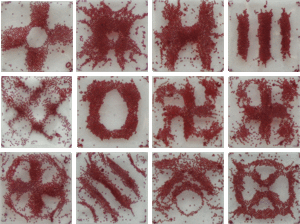Faraday wave
Faraday waves, also known as Faraday ripples, named after Michael Faraday, are nonlinear standing waves that appear on liquids enclosed by a vibrating receptacle. When the vibration frequency exceeds a critical value, the flat hydrostatic surface becomes unstable. This is known as the Faraday instability. Faraday first described them in an appendix to an article in the Philosophical Transactions of the Royal Society of London in 1831.[1][2]
If a layer of liquid is placed on top of a vertically oscillating piston, a pattern of standing waves appears which oscillates at half the driving frequency, given certain criteria of instability.[3] This relates to the problem of parametric resonance. The waves can take the form of stripes, close-packed hexagons, or even squares or quasiperiodic patterns. Faraday waves are commonly observed as fine stripes on the surface of wine in a wineglass that is ringing like a bell. Faraday waves also explain the 'fountain' phenomenon on a singing bowl.
The Faraday wave and its wavelength is analogous to the de Broglie wave with the de Broglie wavelength in quantum mechanics.[4]
Application

Faraday waves are used as a liquid-based template for directed assembly of microscale materials including soft matter, rigid bodies, biological entities (e.g., individual cells, cell spheroids and cell-seeded microcarrier beads).[5] Unlike solid-based template, this liquid-based template can be dynamically changed by tuning vibrational frequency and acceleration and generate diverse sets of symmetrical and periodic patterns.
This phenomenon is also used by alligators to call mates. They vibrate their lungs at low frequencies slightly below the surface, causing their spikes to move and induce surface waves. These surface waves are basically Faraday waves and one can observe the splashing effect characteristic of certain resonances.[6][7]
See also
References
- ↑ Faraday, M. (1831) "On a peculiar class of acoustical figures; and on certain forms assumed by a group of particles upon vibrating elastic surfaces", Philosophical Transactions of the Royal Society (London), vol. 121, pages 299–318. "Faraday waves" are discussed in an appendix to the article, "On the forms and states assumed by fluids in contact with vibrating elastic surfaces". This entire article is also available on-line (albeit without illustrations) at "Electronic Library".
- ↑ Others who investigated "Faraday waves" include: (1) Ludwig Matthiessen (1868) "Akustische Versuche, die kleinsten Transversalwellen der Flüssigkeiten betreffend" (Acoustic experiments concerning the smallest transverse waves of liquids), Annalen der Physik, vol. 134, pages 107–117 ; (2) Ludwig Matthiessen (1870) "Über die Transversalschwingungen tönender tropfbarer und elastischer Flüssigkeiten" (On the transverse vibrations of ringing low-viscosity and elastic liquids), Annalen der Physik, vol. 141, pages 375–393 ; (3) John William Strutt (Lord Rayleigh) (1883), "On the crispations of fluid resting upon a vibrating support," Philosophical Magazine, vol. 16, pages 50–58.
- ↑ Wright, P.H.; Saylor, J.R. (September 2003). "Patterning of particulate films using Faraday waves" (PDF). Review of Scientific Instruments. 74 (9): 4063–4070. Bibcode:2003RScI...74.4063W. doi:10.1063/1.1602936. Retrieved 4 May 2016.
- ↑ John W. M. Bush: Quantum mechanics writ large – http://www.tcm.phy.cam.ac.uk/~mdt26/tti_talks/deBB_10/bush_tti2010.pdf
- ↑ P. Chen, Z. Luo, S. Guven, S. Tasoglu, A. Weng, A. V. Ganesan, U. Demirci, Advanced Materials 2014, 10.1002/adma.201402079. http://onlinelibrary.wiley.com/doi/10.1002/adma.201402079/abstract
- ↑ Powell, Devin. "Horny Male Alligators Bellow With Their Back Spikes". Wired. Wired. Retrieved 4 May 2016.
- ↑ Moriarty, Peter; Holt, R. Glynn (2011). "Faraday waves produced by periodic substrates: Mimicking the alligator water dance". The Journal of the Acoustical Society of America. 129 (4). Bibcode:2011ASAJ..129.2411M. doi:10.1121/1.3587858. Retrieved 4 May 2016.
External links
- YouTube video of Faraday waves in corn starch.
- YouTube video Yves Couder Explains Wave/Particle Duality via Silicon Droplets
- YouTube video of Singing Bowl creating Fountain